-
€
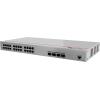
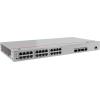

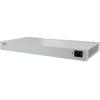
Huawei S310-24P4S è uno switch gestito della serie eKitEngine. È dotato di 24 porte Gigabit Ethernet (10/100/1000 Mbps) e 4 slot SFP (1 Gbps). Su tutte le porte Ethernet è presente un'uscita di alimentazione PoE+; la potenza massima per porta è di 15,4 W con 802.3af o 30 W con 802.3at. Il budget di potenza totale per l'intero dispositivo è di 400 W, decisamente superiore a quello offerto dalle soluzioni della serie S110, più economiche. Lo switch offre gestione Layer 2 e funzioni Layer 3 di base e supporta i protocolli Spanning Tree (STP / RSTP / MSTP) e il moderno standard ERPS (Ethernet Ring Protection Switching). È dotato di una funzione Smart Link che consente di creare una connessione di backup. È possibile collegare la serie S310 a più switch di aggregazione utilizzando connessioni multiple, garantendo così il funzionamento della rete in caso di danni a uno dei cavi. Il prodotto offerto si distingue per le funzioni di sicurezza avanzate, è protetto da vari tipi di attacchi (tra cui DoS, spoofing IP/MAC o SYN flood), utilizza lo Snooping DHCP e ricorda le voci ARP, proteggendo così dallo spoofing ARP.
Un ulteriore vantaggio è il supporto iStack: più switch possono essere virtualmente impilati in un unico dispositivo. La gestione avviene tramite interfaccia Web UI, CLI lb SNMP. Il dispositivo supporta la gestione cloud e l'app eKit. È dotato di un alimentatore CA integrato e di un raffreddamento attivo con regolazione intelligente della velocità della ventola. L'S310-24P4S combina le funzioni di uno switch core e di uno switch di accesso. Grazie all'alimentazione PoE+, è possibile collegare direttamente gli access point, il che si rivelerà utile nelle reti di piccole e medie dimensioni. Allo stesso tempo, non si rinuncia alla gestione avanzata offerta dalla serie di switch S310.
La nuova versione del software (R24 o successiva) riduce significativamente il tempo di avvio, migliora la regolazione delle ventole e aumenta notevolmente le capacità di gestione dall'interfaccia Web. Consente di configurare la maggior parte dei parametri tramite un'interfaccia grafica, mentre in precedenza molte funzioni erano disponibili solo dalla CLI.
Si consiglia di aggiornare i dispositivi alla versione R24! Il software può essere richiesto al nostro servizio di assistenza - support@cdr.pl.24 porte Gigabit Ethernet, 4 slot SFP
Lo switch è dotato di 24 porte Gigabit Ethernet (10/100/1000 Mbps) e quattro slot SFP (1 Gbps). La capacità di switching è di 56 Gbps e la velocità di inoltro dei pacchetti è di 42 Mp/s. Con uno degli slot SFP è possibile creare una connessione anche su distanze molto lunghe utilizzando un cavo in fibra ottica.
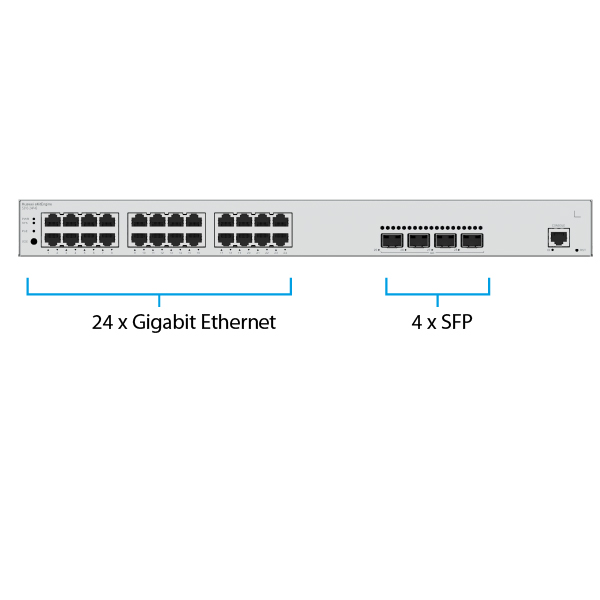
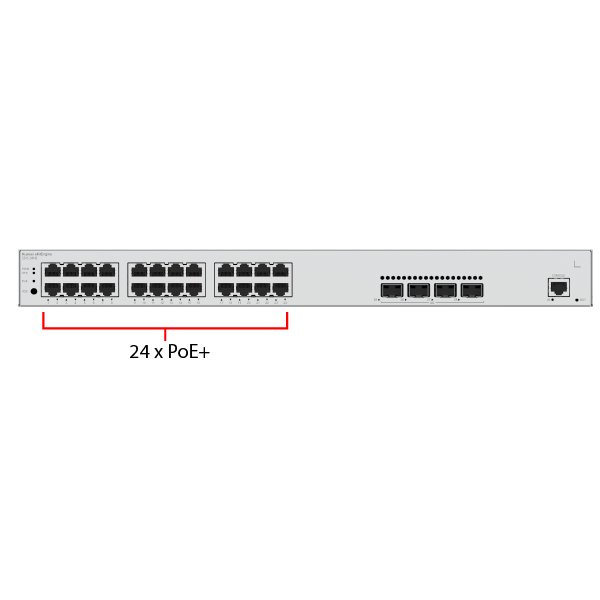
24 uscite PoE+
Tutte le porte Ethernet dispongono di un'uscita di alimentazione PoE+. La potenza massima in uscita per porta, secondo gli standard, è di 15,4 W a 802.3af o 30 W a 802.3at. Il budget di potenza totale per l'intero dispositivo è di 400 W, un valore significativamente superiore a quello offerto dalle soluzioni della serie S110. Ciò consente di caricare tutte le porte utilizzando lo standard 802.3af, necessario in reti di grandi dimensioni con più punti di accesso.
L'uso del PoE consente di effettuare la trasmissione di energia e dati tramite un cavo Ethernet. Con questo tipo di switch, è sufficiente far passare un solo cavo per ogni punto di accesso, senza dover ricorrere a ulteriori alimentatori.
Gestione Layer 2+, iStack
Il dispositivo supporta pienamente la gestione Layer 2 e dispone inoltre di funzionalità Layer 3 di base, come il routing statico. Supporta VLAN, multicast (IGMP Snooping, MLD Snooping), funzionalità QoS e liste di controllo degli accessi (ACL). Supporta i protocolli Spanning Tree (STP / RSTP / MSTP) e il moderno standard ERPS (Ethernet Ring Protection Switching) definito in IUT-T G.8032.
Lo switch garantisce la necessaria sicurezza di rete. Protegge dagli attacchi DoS - SYN flood, Land, Smurf e ICMP flood. È inoltre protetto dagli attacchi diretti dall'utente: attacchi al server DCHP, spoofing IP/MAC, request flood DHCP o DHCP CHADDR.
La serie S310 supporta iStack, ovvero la possibilità di impilare logicamente più switch in un unico switch virtuale. Questo semplifica la gestione della rete e consente di creare connessioni di backup aggiuntive per proteggersi da potenziali guasti.
La gestione avviene tramite GUI Web, CLI o SNMP (v1, v2c, v3) / SSH2.0. La serie S310 può essere gestita anche nel cloud, nel qual caso è possibile utilizzare l'app Huawei eKit.
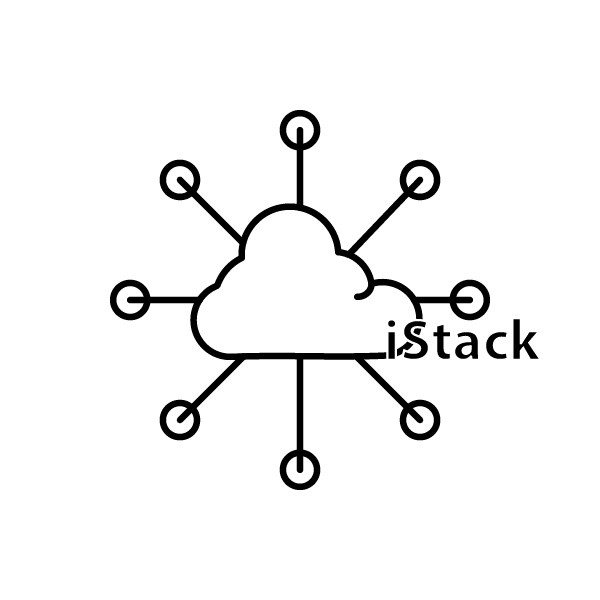
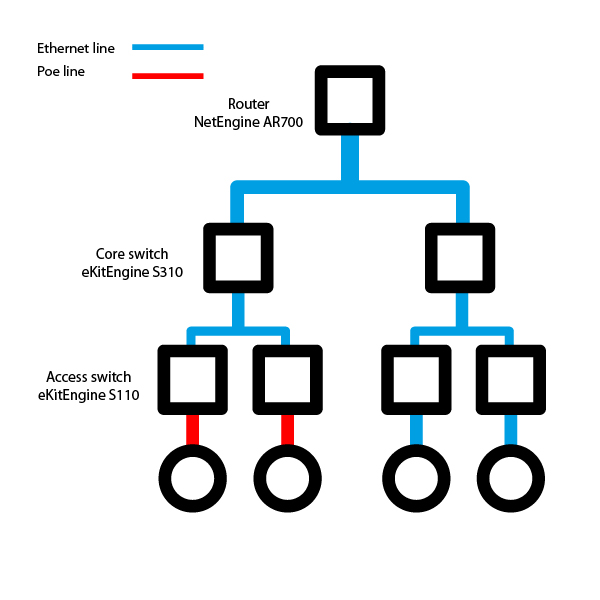
Applicazione
L'S310-24P4S combina le caratteristiche di uno switch master e di uno switch di accesso. Dispone di funzioni di gestione avanzate e supporta iStack, oltre all'uscita di alimentazione PoE su tutte le porte Ethernet. Il dispositivo è ideale per le reti di uffici con diversi punti di accesso. Non è necessario utilizzare switch PoE aggiuntivi, riducendo così i costi di costruzione della rete.
Caratteristiche
| Huawei S310-24P4S | |
| Capacità di commutazione | 56 Gb/s |
| Velocità di inoltro dei pacchetti | 42 Mp/s |
| Porte |
24x gigabit Ethernet 10/100/1000 Mb/s z PoE+ 4x SFP (1 Gb/s) |
| Dimensioni | 43.6 mm x 442 mm x 220 mm |
| Altezza | 1U |
| Peso | 2,92 kg |
| Metodo di alimentazione | Adattatore CA incorporato |
| Tensione di ingresso nominale | 100 - 240 V AC, 50/60 Hz |
| Intervallo di tensione d'ingresso | 90 - 290 V AC, 55/65 Hz |
| Consumo massimo di energia |
Senza PoE: 47,1 W Con PoE: 491,66 W (budget PoE: 400 W) |
| Volume |
A temperatura normale: 49,3 dB (A) Ad alta temperatura: 63 dB (A) |
| Temperatura di funzionamento consentita | Da -5 a 50 C |
| Temperatura di stoccaggio consentita | Da -40 a 70 C |
| Umidità ammessa | 5%-95% senza condensa |
| Protezione da sovratensione delle porte di servizio | ±7 kV |
| Protezione da sovratensione dell'attacco di alimentazione | ±6 kV |
| Raffreddamento | Regolazione attiva e intelligente delle velocità del ventilatore |
| Caratteristiche del software | |
|---|---|
| Tabella indirizzi MAC |
Automatico MAC address learning / aging Massimo 16K indirizzi MAC Inserimento di indirizzi MAC statici / dinamici / blackhole Filtraggio dell'indirizzo MAC di origine Limite di indirizzi MAC memorizzati per interfaccia |
| VLAN |
4094 VLAN Voice VLAN MUX VLAN Assegnazione di VLAN in base a indirizzo MAC, protocollo, sottorete IP, policy e porte VLAN stacking |
| Ethernet switching |
Topologia Smart Link tree e Smart Link multi-instance G.8032 ERPS (Ethernet Ring Protection Switching) STIP (IEEE 802.1d), RSTP (IEEE 802.1w), MSTP (IEEE 802.1s) Protezione BPDU / root / loop Tunnel BPDU |
| Multicast | IGMP v1 / v2 / v3, IGMP v1 / v2 / v3 snooping e MLD snooping |
| Routing IP |
Routing statico e PBR (policy-based routing)
Fino a 512 FIBv6 |
| Caratteristiche IPv6 |
ND (neighbor discovery) PMTU IPv6 ping, IPv6 tracert, IPv6 telnet |
| Stabilità |
LACP (Link Aggregation Control protocol) VRRP (Virtual Router Redundancy Protocol) BFD (Bidirectional Forwarding Detection) LLDP (Link Layer Discovery Protocol) |
| Modalita' QoS / Controllo di accesso ACL |
Limite di traffico basato su inbound / outbound per porta Inoltro dei pacchetti Two-rate three-color CAR, instradamento del traffico basato sulla porta 8 code per porta Algoritmi di accodamento: DRR, SP e DRR+SP Re-marking delle priorità 802.1p e DSCP ai pacchetti Filtraggio dei pacchetti Layer 2 - Layer 4, filtraggio dei frame errati in base all'indirizzo MAC di origine, all'indirizzo MAC di destinazione, all'indirizzo IP di origine, all'indirizzo IP di destinazione, al numero di porta TCP/UDP, al tipo di protocollo o alla VLAN. Limite di larghezza di banda per coda e traffic shaping per porta Network slicing (VLAN/VXLAN) |
| Sicurezza |
Gestione gerarchica degli utenti e protezione con password Protezione contro gli attacchi DoS, ARP e ICMP Assegnazione di indirizzo IP, indirizzo MAC, ID porta e ID VLAN Isolamento delle porte, sicurezza delle porte, sticky MAC Autenticazione IEEE 802.1X e limite del numero di utenti per porta Metodi di autenticazione multipli tra cui AAA, RADIUS, HWTACACS e NAC SSH v2.0 HTTPS Protezione della CPU Whitelist e blacklist Client DHCP, relay DHCP, server DHCP, snooping DHCP Client DHCPv6, relay DHCPv6 |
| Gestione e manutenzione della rete |
iStack Gestione del cloud basata su NETCONF/YANG VCT (Virtual cable test) Gestione e manutenzione remota della rete tramite Telnet SNMP v1/v2/v3 RMON Gestione tramite sistema web HTTPS LLDP/LLDP-MED Log e allarmi di sistema IEEE 802.3az EEE (Energy Efficent Ethernet) Port mirroring Espansione della rete tramite registration query center |
| Interoperabilità |
VBST Compatibilità con PVST, PVST+ e RPVST |






 Polski
Polski English
English Italiano
Italiano Español
Español Čeština
Čeština Српски
Српски Deutsch
Deutsch Ελληνικά
Ελληνικά Slovenský
Slovenský




